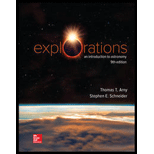
Loose Leaf For Explorations: Introduction To Astronomy
9th Edition
ISBN: 9781260432145
Author: Thomas T Arny, Stephen E Schneider Professor
Publisher: McGraw-Hill Education
expand_more
expand_more
format_list_bulleted
Textbook Question
Chapter 10, Problem 4QFR
What are the major gaseous substances that make up Jupiter and Saturn?
Expert Solution & Answer
Want to see the full answer?
Check out a sample textbook solution
Students have asked these similar questions
Why has Jupiter retained most of its original atmosphere?
6
What is responsible for Jupiter's enormous magnetic field?
Chapter 10 Solutions
Loose Leaf For Explorations: Introduction To Astronomy
Ch. 10 - Prob. 1QFRCh. 10 - What does Jupiter look like?Ch. 10 - How do astronomers know what lies inside the outer...Ch. 10 - What are the major gaseous substances that make up...Ch. 10 - What is the interior structure of Jupiter and...Ch. 10 - Do Jupiter and Saturn have solid surfaces?Ch. 10 - Prob. 7QFRCh. 10 - Prob. 8QFRCh. 10 - What sort of activity has been seen on Io? What is...Ch. 10 - What are the rings of Saturn made of? How do...
Ch. 10 - Prob. 11QFRCh. 10 - Prob. 12QFRCh. 10 - Prob. 13QFRCh. 10 - What is unusual about Uranuss rotation axis? What...Ch. 10 - Prob. 15QFRCh. 10 - Why are Uranus and Neptune so blue?Ch. 10 - Why are the outer planets so large?Ch. 10 - Prob. 18QFRCh. 10 - Prob. 1TQCh. 10 - Prob. 2TQCh. 10 - Ganymede and Callisto orbiting Jupiter and Tethys...Ch. 10 - Approximate the Roche limit as 2.44 times a...Ch. 10 - Prob. 5TQCh. 10 - (10.3) Is Uranuss sky blue for the same reason our...Ch. 10 - Prob. 7TQCh. 10 - Prob. 8TQCh. 10 - Prob. 9TQCh. 10 - Prob. 10TQCh. 10 - Prob. 1PCh. 10 - Prob. 2PCh. 10 - Prob. 3PCh. 10 - Prob. 4PCh. 10 - Prob. 5PCh. 10 - Prob. 6PCh. 10 - Prob. 7PCh. 10 - Prob. 8PCh. 10 - (10.1) The low average densities of Jupiter and...Ch. 10 - Prob. 2TYCh. 10 - Prob. 3TYCh. 10 - Prob. 4TYCh. 10 - Prob. 5TYCh. 10 - Prob. 6TYCh. 10 - Prob. 7TY
Knowledge Booster
Learn more about
Need a deep-dive on the concept behind this application? Look no further. Learn more about this topic, physics and related others by exploring similar questions and additional content below.Similar questions
- What is the primary source of Jupiter’s internal heat?arrow_forwardHow many times more pressure exists in the interior of Jupiter compared to that of Earth?arrow_forwardHow do the interiors of Jupiter and Saturn differ? How does this difference affect the magnetic fields of Jupiter and Saturn?arrow_forward
- Describe and compare the rings of Saturn and Uranus, including their possible origins.arrow_forwardJupiter is denser than water, yet composed for the most part of two light gases, hydrogen and helium. What makes Jupiter as dense as it is?arrow_forwardThe ring systems around Jupiter and Saturn lie outside those planets respective Roche limits. True or false? How do you know?arrow_forward
- Describe four differences between the two ice giants, Uranus and Neptune, and the two gas giants, Jupiter and Saturn. (Hint: Review Celestial Profiles for all of these planets.)arrow_forwardWhy is Pluto not considered a major planet, and what other peculiarity distinguishes it from the major planets?arrow_forwardAllarrow_forward
arrow_back_ios
SEE MORE QUESTIONS
arrow_forward_ios
Recommended textbooks for you
 Foundations of Astronomy (MindTap Course List)PhysicsISBN:9781337399920Author:Michael A. Seeds, Dana BackmanPublisher:Cengage Learning
Foundations of Astronomy (MindTap Course List)PhysicsISBN:9781337399920Author:Michael A. Seeds, Dana BackmanPublisher:Cengage Learning
 AstronomyPhysicsISBN:9781938168284Author:Andrew Fraknoi; David Morrison; Sidney C. WolffPublisher:OpenStax
AstronomyPhysicsISBN:9781938168284Author:Andrew Fraknoi; David Morrison; Sidney C. WolffPublisher:OpenStax An Introduction to Physical SciencePhysicsISBN:9781305079137Author:James Shipman, Jerry D. Wilson, Charles A. Higgins, Omar TorresPublisher:Cengage Learning
An Introduction to Physical SciencePhysicsISBN:9781305079137Author:James Shipman, Jerry D. Wilson, Charles A. Higgins, Omar TorresPublisher:Cengage Learning

Foundations of Astronomy (MindTap Course List)
Physics
ISBN:9781337399920
Author:Michael A. Seeds, Dana Backman
Publisher:Cengage Learning


Astronomy
Physics
ISBN:9781938168284
Author:Andrew Fraknoi; David Morrison; Sidney C. Wolff
Publisher:OpenStax

An Introduction to Physical Science
Physics
ISBN:9781305079137
Author:James Shipman, Jerry D. Wilson, Charles A. Higgins, Omar Torres
Publisher:Cengage Learning

Kepler's Three Laws Explained; Author: PhysicsHigh;https://www.youtube.com/watch?v=kyR6EO_RMKE;License: Standard YouTube License, CC-BY